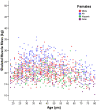Sarcopenia, dynapenia, and the impact of advancing age on human skeletal muscle size and strength; a quantitative review - PubMed (original) (raw)
Sarcopenia, dynapenia, and the impact of advancing age on human skeletal muscle size and strength; a quantitative review
W Kyle Mitchell et al. Front Physiol. 2012.
Abstract
Changing demographics make it ever more important to understand the modifiable risk factors for disability and loss of independence with advancing age. For more than two decades there has been increasing interest in the role of sarcopenia, the age-related loss of muscle or lean mass, in curtailing active and healthy aging. There is now evidence to suggest that lack of strength, or dynapenia, is a more constant factor in compromised wellbeing in old age and it is apparent that the decline in muscle mass and the decline in strength can take quite different trajectories. This demands recognition of the concept of muscle quality; that is the force generating per capacity per unit cross-sectional area (CSA). An understanding of the impact of aging on skeletal muscle will require attention to both the changes in muscle size and the changes in muscle quality. The aim of this review is to present current knowledge of the decline in human muscle mass and strength with advancing age and the associated risk to health and survival and to review the underlying changes in muscle characteristics and the etiology of sarcopenia. Cross-sectional studies comparing young (18-45 years) and old (>65 years) samples show dramatic variation based on the technique used and population studied. The median of values of rate of loss reported across studies is 0.47% per year in men and 0.37% per year in women. Longitudinal studies show that in people aged 75 years, muscle mass is lost at a rate of 0.64-0.70% per year in women and 0.80-00.98% per year in men. Strength is lost more rapidly. Longitudinal studies show that at age 75 years, strength is lost at a rate of 3-4% per year in men and 2.5-3% per year in women. Studies that assessed changes in mass and strength in the same sample report a loss of strength 2-5 times faster than loss of mass. Loss of strength is a more consistent risk for disability and death than is loss of muscle mass.
Keywords: aging; dynapenia; muscle aging; muscle atrophy; muscle quality; sarcopenia; skeletal muscle; strength.
Figures
Figure 1
Muscle mass in 1280 females aged 18–80 years, measured by DXA. With permission Z. M. Wang and A. M. Silva, adapted from Silva et al. (2009).
Similar articles
- Physical function-derived cut-points for the diagnosis of sarcopenia and dynapenia from the Canadian longitudinal study on aging.
Tessier AJ, Wing SS, Rahme E, Morais JA, Chevalier S. Tessier AJ, et al. J Cachexia Sarcopenia Muscle. 2019 Oct;10(5):985-999. doi: 10.1002/jcsm.12462. Epub 2019 Jul 15. J Cachexia Sarcopenia Muscle. 2019. PMID: 31307126 Free PMC article. - Dynapenia and aging: an update.
Manini TM, Clark BC. Manini TM, et al. J Gerontol A Biol Sci Med Sci. 2012 Jan;67(1):28-40. doi: 10.1093/gerona/glr010. Epub 2011 Mar 28. J Gerontol A Biol Sci Med Sci. 2012. PMID: 21444359 Free PMC article. - Leg strength declines with advancing age despite habitual endurance exercise in active older adults.
Marcell TJ, Hawkins SA, Wiswell RA. Marcell TJ, et al. J Strength Cond Res. 2014 Feb;28(2):504-13. doi: 10.1519/JSC.0b013e3182a952cc. J Strength Cond Res. 2014. PMID: 24263662 - Functional consequences of sarcopenia and dynapenia in the elderly.
Clark BC, Manini TM. Clark BC, et al. Curr Opin Clin Nutr Metab Care. 2010 May;13(3):271-6. doi: 10.1097/MCO.0b013e328337819e. Curr Opin Clin Nutr Metab Care. 2010. PMID: 20154609 Free PMC article. Review. - What is dynapenia?
Clark BC, Manini TM. Clark BC, et al. Nutrition. 2012 May;28(5):495-503. doi: 10.1016/j.nut.2011.12.002. Nutrition. 2012. PMID: 22469110 Free PMC article. Review.
Cited by
- Rate of lumbar paravertebral muscle fat infiltration versus spinal degeneration in asymptomatic populations: an age-aggregated cross-sectional simulation study.
Crawford RJ, Volken T, Valentin S, Melloh M, Elliott JM. Crawford RJ, et al. Scoliosis Spinal Disord. 2016 Aug 5;11:21. doi: 10.1186/s13013-016-0080-0. eCollection 2016. Scoliosis Spinal Disord. 2016. PMID: 27536737 Free PMC article. - Increase of resting muscle stiffness, a less considered component of age-related skeletal muscle impairment.
Marcucci L, Reggiani C. Marcucci L, et al. Eur J Transl Myol. 2020 Jun 17;30(2):8982. doi: 10.4081/ejtm.2019.8982. eCollection 2020 Jul 13. Eur J Transl Myol. 2020. PMID: 32782762 Free PMC article. - The Intersection of Aging and Lung Transplantation: its Impact on Transplant Evaluation, Outcomes, and Clinical Care.
Koons B, Anderson MR, Smith PJ, Greenland JR, Singer JP. Koons B, et al. Curr Transplant Rep. 2022 Sep;9(3):149-159. doi: 10.1007/s40472-022-00365-2. Epub 2022 Apr 21. Curr Transplant Rep. 2022. PMID: 36341000 Free PMC article. - Using a Stacked Autoencoder for Mobility and Fall Risk Assessment via Time-Frequency Representations of the Timed Up and Go Test.
Chen SH, Lee CH, Jiang BC, Sun TL. Chen SH, et al. Front Physiol. 2021 May 28;12:668350. doi: 10.3389/fphys.2021.668350. eCollection 2021. Front Physiol. 2021. PMID: 34122139 Free PMC article. - Identifying the Structural Adaptations that Drive the Mechanical Load-Induced Growth of Skeletal Muscle: A Scoping Review.
Jorgenson KW, Phillips SM, Hornberger TA. Jorgenson KW, et al. Cells. 2020 Jul 9;9(7):1658. doi: 10.3390/cells9071658. Cells. 2020. PMID: 32660165 Free PMC article.
References
- Al Snih S., Markides K. S., Ottenbacher K. J., Raji M. A. (2004). Hand Grip strength and incident ADL disability in elderly Mexican Americans over a seven-year period. Aging Clin. Exp. Res. 16, 481–486 - PubMed
- Aloia J. F., Mcgowan D. M., Vaswani A. N., Ross P., Cohn S. H. (1991). Relationship of menopause to skeletal and muscle mass. Am. J. Clin. Nutr. 53, 1378–1383 - PubMed
- Bajekal M., Wheeler L., Dix D. (2006) Estimating residents and staff in communal establishments from the 2001 census. Health Stat. Q. 31, 42–50 - PubMed
LinkOut - more resources
Full Text Sources
Other Literature Sources
